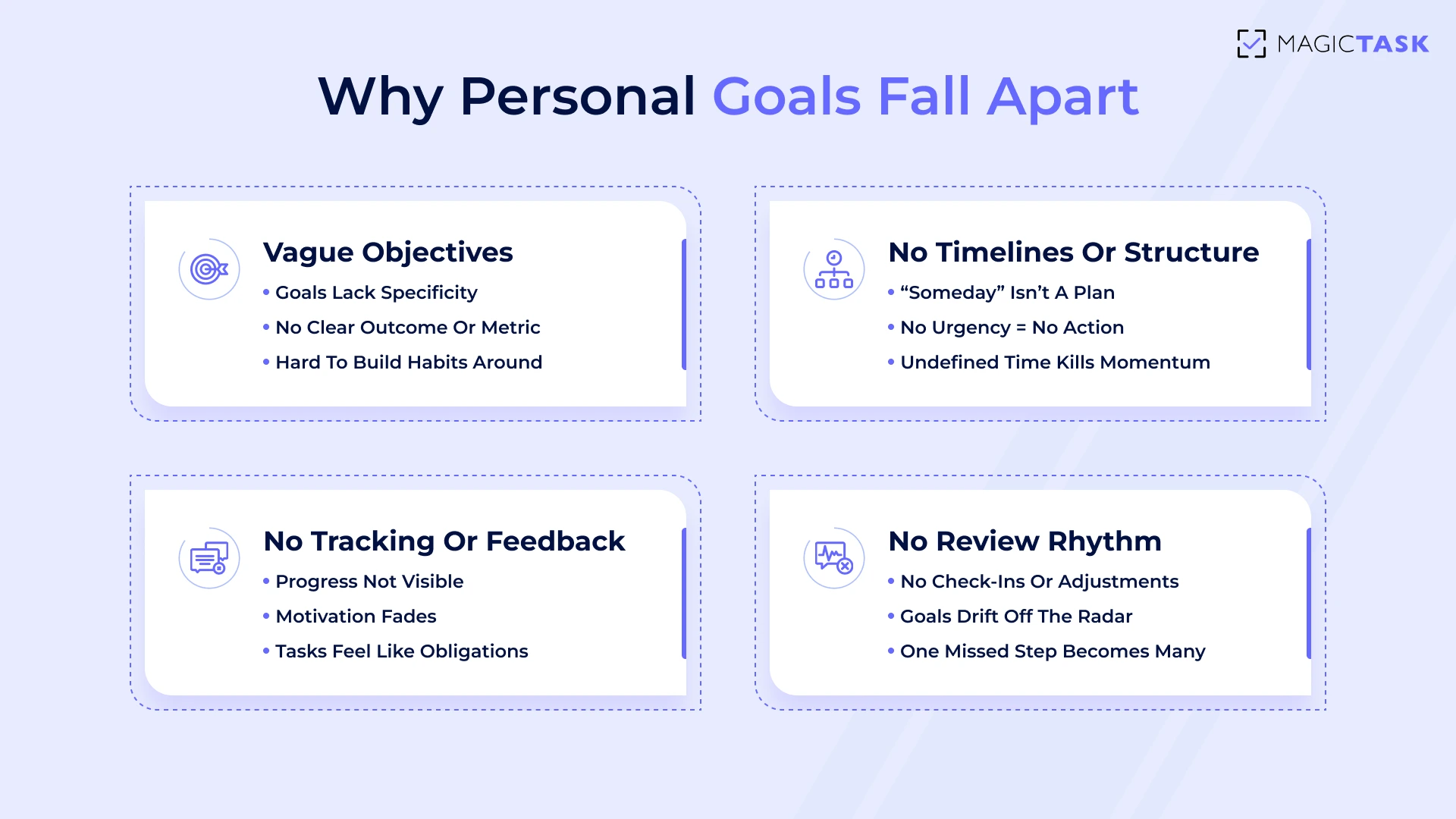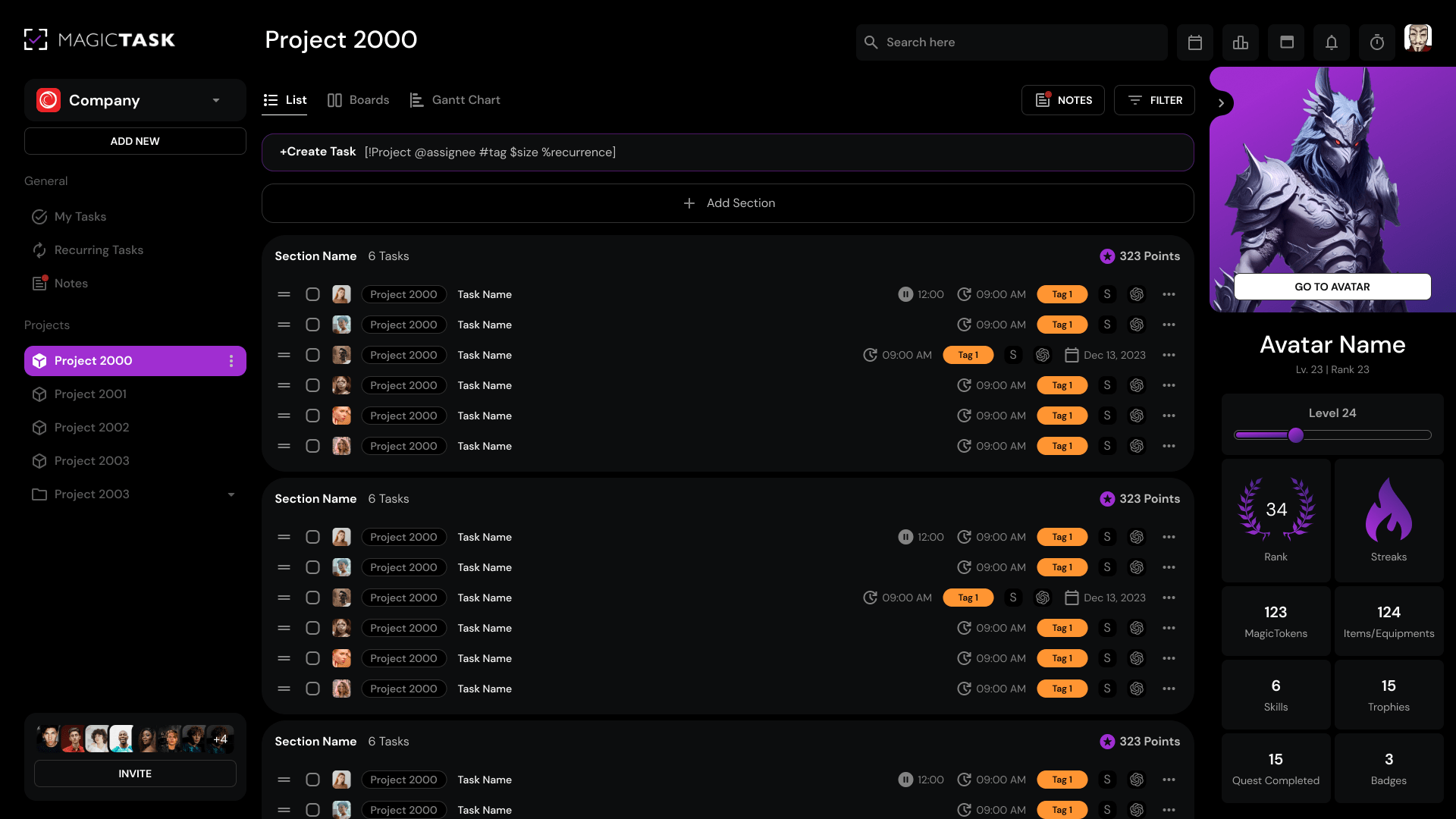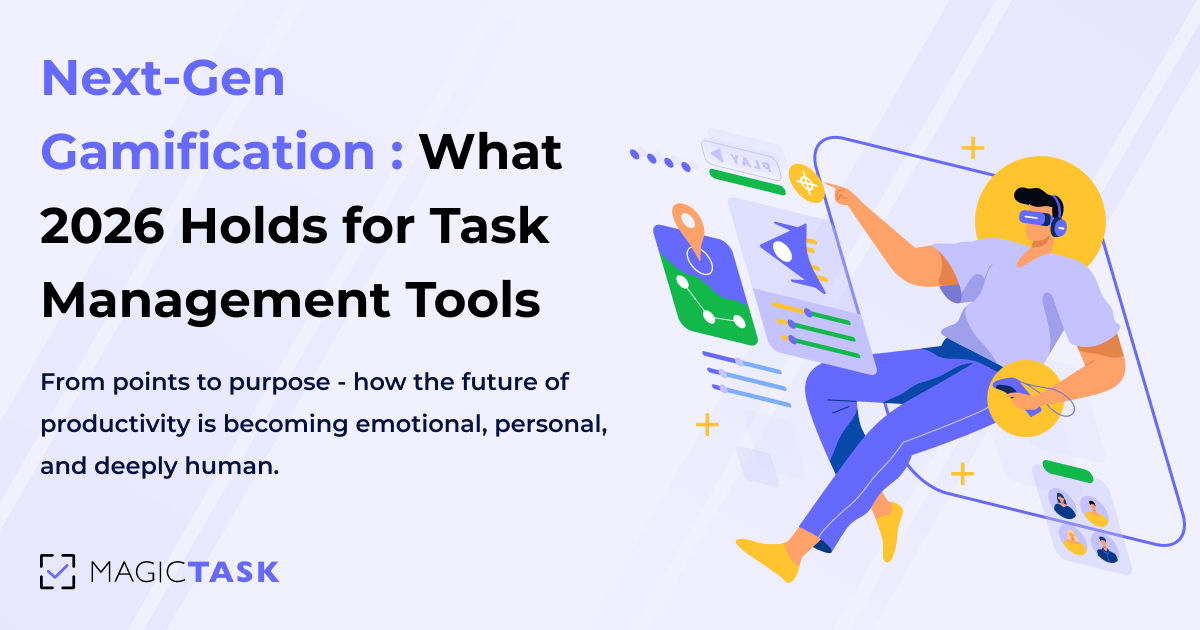How to Set Personal Goals & Crush Them with the Right Tools

Setting goals feels good, until life gets in the way. One week you’re motivated, the next you’re drowning in distractions. That goal tracker? Just sitting there, collecting digital dust.
Sound familiar?
You’re not alone. In fact, 92% of people never achieve their goals. And it’s not because they lack motivation. It’s because they don’t have the right system to keep momentum going when life gets busy.
Whether you’re trying to get in shape, build a side project, or simply bring some order to the chaos, structure makes all the difference.
This guide isn’t just about setting personal goals. It’s about following through and using the right tools to crush them.
Let’s break down how.
Why Most Goals Fail (And What to Do Instead)
But before we start, we need to understand why so many of them quietly slip through the cracks. Let’s take a closer look.
1. Vague Objectives
We’ve all been there.
You tell yourself, “I’m going to get healthy,” or “I want to be more productive.”
It feels ambitious. Optimistic, even. But what does it mean?
Without a specific outcome and a straightforward way to measure it, your brain has nothing solid to grab onto. It’s like setting out on a road trip without a map or directions. You’re moving, but not toward anything concrete.
Clarity drives action.
“Walk 3 times a week before work” gives you a target.
“Write one blog post by Friday” sets a rhythm.
The more specific the goal, the easier it is to build habits around it and the harder it is to procrastinate. Vague goals feel good in theory. Clear goals get done.

2. Lack of Structure or Timeline
Even the most explicit goal can fall apart if it’s floating in undefined time.
“Someday” might sound like a plan, but it’s just procrastination dressed in optimism.
As Amy Morin writes in Forbes, "the biggest obstacle to reaching our goals isn’t a lack of ambition, but the lag between thinking about change and taking action."
We misfile deadlines mentally, based on how we categorize time.
If a goal’s deadline feels like it belongs to the “future,” we subconsciously delay action.
But when it feels part of the “now,” we’re more likely to act.
The clearer your timeframe, the faster your motivation follows. And once time has a shape, momentum finally has somewhere to go.
3. No Tracking or Feedback Mechanism
Clear goals help you start. However, without feedback, it’s challenging to persevere.
A goal without any visible progress quickly becomes invisible to your motivation.
Our brains crave reinforcement. Those minor signs that say, “Yes, this is working.” When you don’t see progress, effort starts to feel pointless, and your energy fades fast.
Behavioral psychology tells us that even micro-feedback, like a visual tick, a progress bar, or the satisfying sound of completion, can trigger dopamine, reinforcing the behavior and pulling you back for more.
But traditional systems often leave you staring at the same unchanged checklist for days. No feedback. There is no sense of momentum. It's just an ever-growing list of things to do.
When feedback is missing, motivation suffers:
- There’s no “win” moment to acknowledge effort
- Tasks feel like obligations, not milestones
- Without proof of progress, doubt takes over
- The gap between where you are and where you want to be feels wider
Without progress, even the best goals lose their spark.
4. No Rhythm For Review or Adjustment
Setting a goal is only the beginning. Sticking with it requires rhythm.
Without a regular cadence to check in, reflect, and adjust, goals quietly drift into the background.
One off-week becomes two.
A skipped task turns into abandonment.
Before you know it, you’re staring at a forgotten project and wondering what happened.
Fixing this isn’t about pushing harder. It’s about building smarter. A system that reminds you to course-correct makes consistency feel natural, not forced.
Here's a step by step framework.
Step 0: Before You Set a Goal: Design for Clarity and Consistency
Before you start chasing progress, pause for precision.
Most goal-setting misfires not because of laziness but because of fuzziness. A goal that’s misaligned from the start can’t be saved by motivation alone.
To achieve actual momentum, not just intention, you need a foundation of clarity and consistency.
That starts before you ever write the first task. Let’s talk about how to design goals that hold up when life gets busy.
1. Choose Outcome + Time Frame
Vague dreams like “get better at writing” or “be healthier” sound noble, but they don’t move the needle.
Real progress begins when you define what success looks like and when you expect it to happen.
Anchor your goal with two things:
- A specific outcome: What will be true when this goal is complete?
- A Realistic Timeframe: When Should You Check for Progress or Completion?
Example:
| 📌 Vague Goal | ✅ Clear Goal With Timeline |
|---|---|
| Become a better writer | Write 4 blog posts this month |
| Get fit | Complete 12 strength workouts in 30 days |
| Start a business | Launch landing page and 3-product test by Aug 15 |
The clearer the win condition, the easier it becomes to take action. Your goal should feel like a mission with a deadline, not an open-ended wish.
2. Define Your Why
You don’t need to define your “why” to set a goal, but it helps more than most people think.
When motivation fades (and it will), your why is what gets you back on track. It’s the difference between dragging yourself through a checklist and showing up for something that matters to you.
Your “why” doesn’t need to be poetic. It just needs to be personal.
Ask Yourself:
- What will this goal help me feel, do, or become?
- What problem will it solve in my daily life?
- Who else benefits if I stay consistent?
When your “why” is crystal clear, you’re not just chasing a task; you’re pursuing meaning. That makes everything easier to stick with, even when life gets messy.
3. Break It Down Early
Even the most inspiring goal becomes a mental burden when it remains too large for too long.
That’s why breaking it down early is essential to protect your momentum.
Instead of staring at a vague monthly outcome, map out what success looks like week by week. You’ll make smarter decisions, avoid burnout, and feel that satisfying sense of progress early and often.
MagicTask makes this easy.
You can simply add the main task and subtasks, assign sizes based on time or complexity, and that's it!
Here’s how a goal breakdown: “Launch a Personal Website in 4 Weeks”, looks like:
| 📅 Week | 🧩 Main Task | Size | ✅ Sub Tasks |
|---|---|---|---|
| 1 | Choose a platform and a domain for the website | M |
|
| 2 | Build the homepage and the about section | L |
|
| 3 | Set up blog + contact form | M |
|
| 4 | Go live + share on social | L |
|
Each task has a precise size. You can even assign sizes to the subtasks. Each subtask gives your brain something specific to do at the moment. That’s how goals become habits and results.
Step 1: Turn Your Goal Into a Daily Execution Plan
By now, your goal has a clear outcome, a solid why, and a manageable roadmap. That’s half the battle.
What comes next?
Turning those well-crafted plans into daily momentum, the kind that builds confidence, builds habits, and gets things done.
1. Build a Weekly Template
You don’t need to guess your way through progress.
One of the simplest ways to make momentum predictable is by establishing a weekly rhythm, a consistent pattern of work sessions you can rely on.
Instead of “fit it in when there’s time,” block out consistent windows to focus.
Three 45-minute work blocks per week can turn into serious output over time without feeling like you’ve added more to your plate.
Here’s what that might look like:
- Monday (9:00–9:45 AM): Research & Planning
- Wednesday (2:00–2:45 PM): Draft or Build Phase
- Friday (10:30–11:15 AM): Review & Ship
Pro tip: Use MagicTask’s task view or calendar integration to visually map these blocks. It offers structure without stress, making execution feel intentional rather than accidental.
2. Protect Goal Time
Your most important work deserves more than “leftover” time.
When you carve out dedicated blocks for your goal-related tasks, you turn vague intentions into real appointments.
Adding these sessions to your calendar signals that this work is essential.
Label your time blocks with clarity and purpose. Treat them with the same respect you’d give a meeting with your CEO.
And when your schedule reflects your priorities, not just your to-dos, you stop scrambling for time and start working with intention.
With MagicTask’s daily planner, you can align those blocks with actionable steps, making progress feel natural rather than forced.
Tools That Help You Stick With It
Setting goals and structuring your days is only half the equation.
The real challenge is sticking with it, especially when distractions multiply and motivation dips.
That’s where the right tools come in. Not to add complexity but to reduce friction, track progress, and keep you engaged for the long run.
1. MagicTask
Most goal-setting systems break down not because people stop caring, but because they stop feeling the payoff.
When your to-do list becomes a graveyard of unchecked boxes, motivation fizzles. You need more than just structure.
You need momentum.
That’s where MagicTask shifts the game.
Instead of making goals feel heavier, it makes them feel lighter through playful design and progress, which is visible.

Here's how it helps:
- Simple to Use
Task management systems should be easy and clutter-free. Most of the platforms out there, such as Notion, are too complex.
With MagicTask, you can start in no time. All you have to do is mind-map all your tasks in a clean interface and then drag tasks to the "My Focus" area, focusing on those tasks only.
- Gamification
MagicTask comes with unique gamification features. As you complete tasks, you unlock "MagicTokens". You can use these tokens to purchase themes, skins, and much more.
The themes aren’t just for fun. They’re a visual celebration of progress that keeps you coming back. Motivation shifts from abstract ("be productive") to concrete ("level up and earn this theme pack").
Together, these features turn your goals into a game worth playing, and, more importantly, one you’ll want to finish.
2. Google Calendar
Goals slip through the cracks of unguarded time.
That’s where Google Calendar comes in. They don’t just organize your day but also protect your priorities.
Use it to:
- Time-block focused work sessions: Mornings tend to be your sharpest mental hours—claim them. Add recurring calendar blocks for goal-related tasks, just as you would for meetings. This shifts your mindset from “optional” to “non-negotiable.”
- Create a visual rhythm: With a few clicks, you can map out your weekly execution plan—whether it’s 3x45-minute sprints or daily 20-minute progress pushes. Seeing that rhythm on your calendar reinforces commitment.
- Sync with MagicTask: When your calendar and task manager are aligned, your days become smoother. Less toggling, less guessing—just clear, actionable momentum.
These tools turn time from your biggest stressor into your most reliable ally.
Step 3: Adjust, Track, and Stay in the Game
You’ve laid the groundwork. Your goals are clear, broken down, and supported by the right tools.
But real success?
That comes from staying in the game long after the excitement wears off.
1. Weekly Review
Consistency doesn’t mean perfection; it means staying connected to your goals, even when the week doesn’t go as planned.
A simple weekly review keeps your progress visible and your focus aligned.
Ask yourself:
- Did I complete what I said I would?
- What worked well, and what didn’t?
- Was my goal too ambitious, too broad, or too reliant on external factors?
- What blocked me, and how can I adjust to it?
These reflections are about course correction. Use them to tweak your task sizes, shift your energy investment, or even change your environment.
A few minutes of honest review each week can help keep your goals from slipping away silently.
2. Keep Checking Your Progress
Progress is a psychological necessity.
Without tangible signs that you’re moving forward, even the hardest-working day can feel like a standstill.
That’s why MagicTask is built to make your progress impossible to miss, and incredibly satisfying to witness.
Each time you complete a task, you’re not left in silence.
You hear a subtle chime, see your points tick upward, and watch your chosen theme inch closer to its next level.
That instant feedback delivers a dopamine hit that your brain associates with achievement.
Traditional to-do lists offer checkboxes.
MagicTask offers a sense of accomplishment. It shows you a visual log of your effort in motion with task streaks, point accumulation, leveling systems, and evolving themes that respond to your consistency.
And here’s the quiet power of visible progress: it builds trust in your momentum.
When you can see how far you’ve come, you stop questioning whether the next step is worth it. You take it naturally.
3. Build Restart Rituals
Momentum can break when life happens. However, the key difference between individuals who abandon their goals and those who achieve them is perseverance.
Instead of spiraling into guilt when you miss a day (or a week), create a personal reset system.
MagicTask makes this easy. Set up a recurring task, something like “Reboot routine” or “Reset my week.” It’s your built-in pause-and-restart button.
It’s about picking one thing, your next micro-goal, and moving forward. When your tool invites you back with no judgment and a clear next step, you’re far more likely to re-engage.
And that consistency is what crushes goals over time. In fact, people who set specific goals and consistently track their progress are 76% more likely to achieve them. Be a part of that statistic.
Conclusion: Goals Don’t Work Unless You Work the System
Ambition isn’t where most people fall short. It’s the system that breaks down.
Without a clear outcome, a plan of attack, and a way to track your momentum, even the best intentions dissolve into mental clutter and “maybe tomorrow.”
Take ten minutes today. Not to plan your whole year. Just to choose one goal worth finishing.
Open MagicTask or your preferred system. Add it, size the first step, and commit to showing up for it.
The system you build today becomes the consistency that carries you forward tomorrow.




